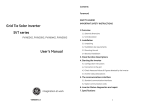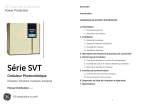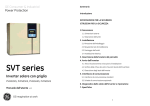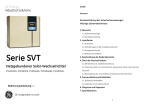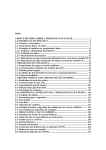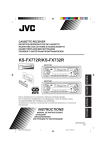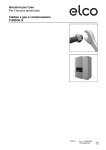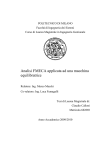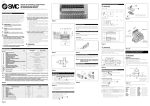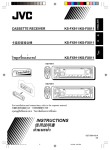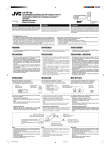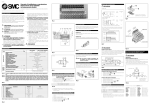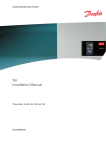Download MS Pro 1-3K 中文中性使用手冊
Transcript
GE Consumer & Industrial Power Protection Contents Foreword SAFETY LEGEND IMPORTANT SAFETY INSTRUCTIONS 1 Overview 1.1 External dimensions 1.2 Unit description 2. Installation 2.1 Unpacking 2.2 Installation site requirements 2.3 Mounting the unit 2.4 Electrical installation 3. Panel function Descriptions 4. Starting the Inverter SVT series Grid Tie Solar Inverter PVIN02KS, PVIN03KS, PVIN04KS, PVIN05KS 4.1 Configuration Instructions 4.2 Connection to the grid 4.3 Check Measured Values & Figures detected by the inverter 4.4 Inverter status descriptions 5. The communications interface 5.1 Standard communication interfaces 5.2 Option communication cards User’s Manual v1.0 6. Inverter Status diagnostics and repair 7. Specifications GE imagination at work 1 Foreword IMPORTANT SAFETY INSTRUCTIONS Thank you for buying this inverter. Many years of experience in the design of power device have gone into construction of this device. We hope that this device will also General Warning! Incorrect operation and work performed incorrectly can cause serious injury & damage! Only qualified staff are authorized to install your inverter and only within the scope of the respective technical regulations. Do not start operation or carry out maintenance work before you have read the chapter “IMPORTANT SAFETY INSTRUCTIONS “! give your solar system many years of trouble-free operation. However, it should be mentioned that an inverter is a complex electronic system which is also confronted with a wide variety of local conditions. If questions arise or a malfunction occurs, do not hesitate to call your specialized dealer. He or she will try to help you as quickly and straightforwardly as possible. Warning! These servicing instructions are for use by qualified personnel only. To reduce the risk of electric shock, do not perform any servicing other than that specified in the operating instructions unless you are qualified to do so. Please read this user's guide carefully to familiarize yourself with the device. Remember to pay special attention to the information on installing and commissioning the device. This manual contains important instructions for the SVT PVIN02KS, PVIN03KS, PVIN04KS, PVIN05KS that shall be followed during installation and maintenance of the SAFETY LEGEND This manual contains important instructions that should be followed during installation and maintenance of the GE Solar Inverter. This manual must be read and inverters. Housing Only qualified installers are authorized to open the connection area. Do not open the connection area when the inverter is in under-voltage condition. Only well-trained service staff may open the upper portion (power stage) of the inverter, and only when it is not in under-voltage condition. understood prior to installing the system. Warning: Indicates a procedure, condition, or statement that, if not strictly observed, could result in personal injury or death. Repair Caution: Indicates a procedure, condition, or statement that, if not strictly observed, could result in damage to or destruction of equipment. Only well-trained service staff is authorized to carry out repairs to the SVT unit. Installation Attention: Indicates a procedure, condition, or statement that should be strictly followed in order to optimize these applications. 2 PV inverter has to be installed with all protection accessories. 3 1. OVERVIEW PV module 1.1 External dimensions Before connecting the solar modules, you must check whether the voltage parameters specified in the manufacturer’s data correspond with the actual parameters. When checking the voltage reading, please take into account that solar modules supply a higher no-load voltage when temperature is low and sunlight level remains unchanged. At -25 °C the open-circuit voltage of the PV modules must never exceed 500 V. The data sheet of the solar module will tell you the temperature factors applicable for ascertaining the theoretical open-circuit voltage at -25 °C. If the solar modules exceed an open-circuit voltage of 500 V, the SVT might be damaged and all warranty right will be voided. The SVT includes a Residual current monitoring unit (RCMU) according to VDE0126-1-1. This device measures the ground current of the PV array and prevents the inverter from feeding the grid in case of a ground fault. References Grid connection PVIN02KS PVIN03KS PVIN04KS PVIN05KS L 455 455 H 430 510 D 170 170 Dimensions (mm) Only appropriately licensed contractors are authorized to connect the SVT to the grid. Consult your local authorities for specific requirements. Before connecting the SVT to the grid, permission for the connection must be granted by the utility company. 4 5 2. Installation 1.2 Unit Description Read the Safety Instruction guide (page 2 to 4) before installing the PV inverter. 2.1 Unpacking Inspect the PV inverter upon receipt. The manufacturer designed robust packaging for your product. However, accidents and damage may occur during shipment. Notify the forwarder and dealer if there is damage. The packaging is recyclable; save it for re-use or dispose of it properly. Remove the inverter from the carton box. Check the package contents. Standard content shall include: 9 1 set of wires + connectors already assembled with cables 9 1 set of data CD-ROM (monitoring software, Multilanguage user’s and software manuals, inverter certifications) 9 (1) LCD & LED Display: Showing the operation information and status of the inverter. (2) Solar array input: Plug-and-play connectors the for connection of the solar 1 set of mounting frame Accessories Kit as below: modules (The SVT PVIN02/03KS/05KP only have one PV string input). (3) Standard communication Port: EPO & RS232. (4) Optional communication slot: USB, RS485, Dry contact, TCP/IP. (5) AC output terminal: AC output for the utility supply. 6 7 2.2 Installation Requirements (2) The SVT is designed to be mounted on a vertical wall. If installing the unit outdoors, make sure that it is not slanting forward. We advise against installing the unit in a horizontal position outdoors. The SVT is heavy (25kg to 29kg). Take this weight into account when choosing the installation site and method of installation. 29kg To ensure proper operation and long operating life, always position the Inverter according to the following requirements: (1) The SVT is designed for outdoor installation and must be installed nor in a place where it is exposed to direct sunlight, neither in an enclosure exposed to direct sunlight. (3) When choosing the installation site, ensure there is enough space for heat dissipation. Under normal conditions, the following guidelines should be applied for the space to be kept clear around the inverter: The yield of the PV system may reduce at increased ambient temperatures or when installed in poorly ventilated and warm indoor locations. We advise the ambient temperature inside the -25 °C to +50 °C range. 8 9 2.3 Mounting the unit Installation step We recommend you to use the supplied wall-mounting bracket to mount the SVT. For Step1: Fit the wall-mounting bracket. vertical installation and installation on solid concrete or block walls, when selecting To mark the positions to drill the holes, the mounting materials, be sure to take into account the weight of the SVT. you can use the wall-mounting bracket as a drilling template. Screws need to be appropriated to material of the wall and the weight of the device. Screw heads to be fully seated not stripped. Step2: Now hang the SVT onto the wall-mounting bracket using its upper mounting plate so that it cannot be moved sideways. If you do not want to use the supplied wall mounting bracket as a template, observe the dimensions shown in the drawing above. The procedure for mounting the inverter using the wall mounting bracket is described on the following pages. Make sure that the inverter is also slotted in the mounting bottom frame Step3: Make sure that the SVT is positioned securely on the bracket. 10 11 2.4 Electrical installation The complete installation for the SVT is shown schematically in the following diagrams (Fig. 1a & b): Fig. 1a Fig. 1b In order to chose size properly your cable application, please refer to the list of suggested cable width In order to chose size properly your cable application, please refer to the list of suggested cable width References PVIN02KS/ PVIN03KS PVIN04KS/ PVIN05KS Sides Diameter Φ (mm) Area (mm²) DC >2.0 >3.5 AC >2.5 >5.0 DC >2.0 >3.5 AC >2.59 >5.5 Reference PVIN05KP Sides Diameter Φ (mm) Area (mm²) DC >2.5 >5.0 AC >2.59 >5.5 The connectors are provided with a 3m cable already crimped and assembled. The connectors are provided with a 3m cable already crimped and assembled. 12 13 2.4.1 Connecting the PV Array (DC) 2.4.1.2 Wiring to PV Module 2.4.1.1 PV Module requirements The SVT is equipped with PV quick connects for connecting up to two PV strings (Only The SVT is designed to be connected to one string for SVT 02KS/03KS/05KP or two SVT references PVIN04KS/ PVIN05KS). strings for SVT 04KS/05KS, of which PV modules are wired in series. Build your PV string having a homogenous structure (modules of the same type, identical orientation, tilt and number), the connecting cables from the PV Modules must also be fitted with this type of plug connector. GE provides the connectors assembled and crimped to 3m cables. We recommend using this assembly to connect the inverter to the DC joint box. List of cables and connectors provided with the inverter. Unit PVIN02KS, PVIN03KS, PVIN04KS PVIN05KS All (sealing caps) Qty 3 3 2 2 1 1 1 1 3 Area mm² 3,31 3,31 3,31 3,31 5,26 5,25 3,31 3,31 - Length 3m 3m 3m 3m 3m 3m 0,2m 0,2m - 3 - - Picture The Guidelines for Matching PV Array to the SVT PV-Inverter Input for determining the number of panels required in the PV string (panels connected in series), you must ensure that the following three requirements are met: 1. To avoid damage to the inverter, make sure the maximum open circuit voltage (Voc) of each PV string is less than 500 VDC under any condition. Voltage over 500 VDC will damage the inverter. Special wiring situation: If application requires alternative wiring, please take special care to crimp the connectors properly. Poor connection may create dangerous situations. 2. Do not exceed the maximum array short circuit-current rating marked on the inverter. The order codes for the various connectors are as follows: Male cable coupler PV-KST4/6Ⅱ Female cable coupler PV-KBT4/6Ⅱ Sealing caps PV-SVK4 Sealing caps PV-BVK4 Male panel receptacle PV-ADSP4/6 Female panel receptacle PV-ADBP4/6 3. To achieve maximum energy harvest from your array, ensure that the VMP (voltage at maximum power) does not drop below 150 VDC or increase above 450 VDC under most conditions. For more information, please refer: www.multi-contact.com 14 15 To wire the PV array to the SVT inverter PVIN02KS, PVIN03KS with several strings, To wire the PV array to the SVT inverter PVIN02KS, PVIN03KS with only one string, follow these steps: follow these steps: Step 1: Make sure the DC breaker on the joint box is switched OFF. Step 1: Make sure the DC breaker on the joint box is switched OFF. Step 2: Check that the PV generator connectors have the right polarity and do not exceed the maximum string voltage. Step 2: Check that the PV generator connectors have the right polarity and do not exceed the maximum string voltage. Step 3: Connect the positive (+) wire from the #1 PV string to Inverter PV positive (+) Step 3: Connect the positive (+) wire from the #1 PV string to Inverter PV positive (+) quick connect. quick connect String A. Step 4: Connect the negative (–) wire from the #1 PV string to Inverter PV negative (–) quick connect. Step 4: Connect the negative (–) wire from the #1 PV string to Inverter PV negative (–) quick connect String A. Step 5: If necessary, repeat step 2 and Step 3 for the others PV string. Double checks that the wires are in the proper locations. Step 5: Close off the unneeded DC input sockets using the protective caps supplied in the accessories kit. +- +-+-+- OFF +- OFF Fig. 2b - DC Connections for a Single-String PV Array Fig. 2a - DC Connections for a 3-String PV Array 16 17 To wire the PV array to the SVT inverter PVIN04KS, PVIN05KS, follow these steps: To wire the PV array to the SVT inverter PVIN05KP, follow these steps: Step 1: Make sure the DC breaker on the joint box is switched OFF. Step 1: Make sure the DC breaker on the joint box is switched OFF. Step 2: Check that the PV generator connectors have the right polarity and do not exceed the maximum string voltage. Step 2: Check that the PV generator connectors have the right polarity and do not exceed the maximum string voltage. Step 3: Connect the positive (+) wire from the #1 PV string to Inverter PV positive (+) Step 3: Connect the positive (+) wire from the #1 PV string to Inverter PV positive (+) quick connect. quick connect String A. Step 4: Connect the negative (–) wire from the #1 PV string to Inverter PV negative (–) quick connect. Step 4: Connect the negative (–) wire from the #1 PV string to Inverter PV negative (–) quick connect String A. Step 5: If necessary, repeat step 2 and Step 3 for the others PV string. Double checks that the wires are in the proper locations. Step 6: Close off the unneeded DC input sockets using the protective caps supplied in the accessories kit. +- +- Step 5: Connect the Inverter PV positive (+) quick connect String A to the Inverter PV positive (+) quick connect String B. Step 6: Connect the Inverter PV positive (-) quick connect String A to the Inverter PV positive (-) quick connect String B. ++-+-+- OFF ++- +-+-+- OFF +- Fig. 2d - DC Connections for a Single-String PV Array Fig. 2c - DC Connections for a Two-String PV Array 18 19 2.4.2 Connecting to the grid (AC utility) (A) Insert utility wires through cable gland. To connect the AC cable, proceed as follows: (B) Connect wires according to polarities indicated on terminal block. Step 1: Before wiring the PV-Inverter, make sure the DC breaker and the AC breaker on the joint boxes are switched OFF. L means LINE (brown ), N means Neutral (blue) and G means system ground(yellow-green) as shown in Fig. 4(a) L1 Step 2: Confirm grid’s (utility’s) voltage and frequency. For the limit values, please refer means LINE1 (black), L2 means LINE2 (black), G means system ground(yellow-green) as shown in Fig. 4(b) to the certificates provided with the inverters. The voltage and frequency of Utility are dependant on different setting in each country. Step 3: OFF Fig. 4 OFF (C) Fix the AC Utility cover of the SVT and tighten the four screws. (D) Fix the cover of the communication port of the SVT and tighten the four screws. Fig. 3 To prevent risk off electric shock, ensure the ground wire is properly earthed before operating the PV Inverter. Recommended torque: 1.2Nm 20 21 3. Front panel Functional Descriptions 4. Starting the inverter 4.1 Configuration Instructions 1 LCD Display Symbol Before any connection to the grid, make sure the inverter is properly configured with the country specifics settings. To do so, you have 2 solutions: Description Utility Source Inverter Working in specified mode Solar Cell SOLUTION 1 - Front Panel Setting Mode Inverter operation mode Flow Chart Only qualified and well-trained installers are authorized to enter in the Setting Mode and change the country setting of the inverter 4 Digits Measurement Display Step 1: After having completed all the hardware installation described at section 2,make sure that • The housing cover is securely screwed tight. • The AC breaker is OFF. • The DC cables (PV strings) are connected. LED Indicators 2 RED LED steadily lights up to indicate that the Ground fault or DC input isolation fault. 3 YELLOW LED steadily lights up to indicate that the utility (ex. Voltage, frequency etc.) is not matches with the input standard of the inverter. 4 Green LED steadily lights up to indicate that the Solar Cell power is greater than sleep power; the LED flashes flickeringly to indicate that the Solar Cell power is smaller than sleep power. Control Keypads 5 Special Function Log in /out 6 Go to previous page. 7 To re-confirm the change of Inverter Setting 8 Go to previous page. Step 2: Connect the PV string voltage by switching ON the DC circuit breaker. The inverter starts automatically when it receives DC voltage greater than 120Vdc. All of the LEDs will light up. LCD will illustrate as Fig. 5a. Fig. 5a After 3 seconds, LCD will illustrate as Fig 5b and Fig 5c. The Green LED flashes flickeringly to indicate that the DC input power is smaller than sleep power. The yellow LED steadily lights up to indicate that no utility exists. Fig. 5b Meaning of A120V A is the name of the string (A or B) 120 is the numerical value of the measurement V is the unit of the measurement Meaning of AL14 AL stands for alarm, it can also be ER for error 14 is the number of the alarm or error Fig. 5c For further explanations, refer to the section 4.2. 22 23 Setting Mode Restart of the inverter The new configuration is kept in the memory of the inverter and you need to restart the inverter to see effective changes on the parameters. Step 3: Press and hold 5 seconds simultaneously the two buttons and . LCD will illustrate as Fig. 5d and Fig. 5e. Fig. 5d Fig. 5e Step 12: So switch OFF the DC breaker, wait until the LCD and the LEDs are OFF, and then switch ON the DC breaker. Country Selection Step 4: Once in the Setting Mode, - Germany - Spain Checking of the new configuration use or to choose the configuration setting in accordance to your country - Italy - France Step 13: After the restart, press the menu button in order to check the new configuration. The inverter will display the 3 parameters you have just changed: ID number, country, and DC - Belgium Step 5: Press input. Use to validate and go to next step. or Fig. 5k Fig. 5l to change the one you want to check. Press again the menu button to exit the visualization mode. Fig. 5m DC Input configuration Step 6: After the country selection, you will have to choose the DC input configuration. LCD will illustrate as Fig. 5f and Fig. 5g. Step 7: Use or input configuration Step 8: Press to choose the DC SOLUTION 2 - Setting Tool Software Fig. 5f This same configuration can be done by the Setting Tool, provided in the SVT Fig. 5g Software suite, for more information, please refer to the Setting Tool user manual. Standard config. (PVIN05KS) 4.2 Connection to the grid Parallel config (PVIN05KP) 4.2.1 Switch ON the AC breaker. If Utility specification (ex. Voltage, frequency etc.) is to validate and go to next step. matched with the specs of the inverter, after 30 seconds the LCD display will illustrate ID configuration Fig. 6a. And the Yellow LED will go out to indicate that the utility is acceptable by the Step 9: After the DC input configuration, you will have to choose the ID of the inverter. LCD will illustrate as Fig. 5h and Fig. 5i. Step 10: Use Step 11: Press illustrate as Fig. 5j. or inverter. If Utility’s specification (ex. Voltage, frequency etc.) is not matched with the Fig. 5h to choose the increment the ID number from specs of the inverter then an error code or error status will be shown on the screen. Fig. 5i to to validate and exit the Setting Mode. LCD will . Fig. 6a 4.2.2 After 5 seconds, if the DC soft start of the inverter is successful, the LCD display Fig. 5j will illustrate Fig. 6b. The Green LED still flashes flickeringly. Fig. 6b 24 25 4.2.3 After 10 seconds, if the AC soft start of inverter is successful the LCD display will illustrate Fig. 6c. 4.3.5 Output Power of Booster A, as Fig. 7e. Fig. 7e Fig. 6c 4.3.6 Output Power of Booster B, as Fig. 7f. 4.2.4 If the inverter is in failure (ex. Output Current Over Range), then an error code or status will be shown on the screen. ( EX. Fig. 6d) Fig. 7f 4.3.7 Output Voltage of Inverter (Utility Voltage) , as Fig. 7g. Fig. 6d 4.2.5 If start-up operation of the inverter is completely and successful. The LCD Fig. 7g 4.3.8 Output Frequency of Inverter (Utility Frequency) , as Fig. 7h. display will illustrate Fig. 6c. Fig. 7h 4.3 Check Measured Values & Figures detected by the inverter If you would like to check the measured values & figures detected by the Inverter, please use scroll up and scroll down keypad, the LCD display will illustrate as: keypads. When you use scroll down 4.3.9 Output Current supplied to Load, as Fig. 7i. Fig. 7i 4.3.10 Output Power Supplied to Load, as Fig. 7j. 4.3.1 Input DC Voltage of String A, as Fig. 7a. Fig. 7a Fig. 7j 4.3.11 Energy KWH Supplied to Load, as Fig. 7k. 4.3.2 Input DC Voltage of String B, as Fig. 7b. Fig. 7b Fig. 7k 4.3.12 INVERTER Inner Temperature (ºC, ºF ) , as Fig. 7l. 4.3.3 Input DC Current of String A, as Fig. 7c. Fig. 7l Fig. 7c 4.3.13 Heat sink Temperature (ºC, ºF) , as Fig. 7m. 4.3.4 Input DC Current of String B, as Fig. 7d. Fig. 7m Fig. 7d 26 27 4.4 Inverter status descriptions SVT starts up automatically when DC power from the PV panel is sufficient. Once the 5. The communications interface inverter starts, it enters into one of the following status: Operation mode LCD panel display Description In this mode, the SVT works normally. Whenever the supplied power from PV panel is sufficient (500VDC>PV>120VDC ), the SVT converts power to the grid as generated by the PV panel. In normal mode, the green LED is on to indicate that it feeds power to the grid. Normal If the power is insufficient, (60VDC<PV<120VDC) the SVT enters into a standby mode but attempts to connect to the grid. Stand-by The internal intelligent controller can continuously monitor and adjust the system status. If the SVT finds any unexpected conditions such as grid problems or internal failure, it will display the information on its LCD and light up the red LED. Error 5.1 Standard communication interfaces 5.1.1 RS232 interface definition 5.1.1.1 The RS232 interface shall be set as follows: Baud Rate Data Length Stop Bit Parity 9600 bps 8 bits 1 bit None 5.1.1.2 The Pin Assignments of true RS232 type. The pin assignments of true RS232 type are illustrated as follows: 9 8 7 6 5 4 3 2 1 Pin 2: RS232 Rx Pin 3: RS232 Tx Pin 5: Ground 5.1.2 EPO (Emergency Power Off) RJ45 connector Emergency Power Off Mode. In this mode, the SVT does not take any power from the grid. EPO In case of little or no sunlight, The SVT automatically stops running. In this mode, the SVT does not take any power from the grid. The display and all of the LEDs on the front panel do not work. Shutdown 28 To activate EPO, Pin 4 and Pin 5 have to be shorted together. Make sure the connection between the RJ45 connector and the pair of wires is properly done. Ensure that the functionality of the EPO fits with your application by testing the inverter while it is injecting current; check that it stops injecting the current. 29 5.2 Option communication cards 5.2.2 RS485 Interface Card 5.2.1 Hardware Installation Procedure Open the top and sides of the cabinet - CN1 is for the function of the terminal resistor (which can be monitored on the provided software). Short pin1-2 to enable the function and short pin2-3 to disable it. Put the communication card into the slot - CN2 is for RS485. - CN3 is for remote power. Adaptor recommendation The boards should work with all the RS485 communication ports and adaptors. However, if you don’t have direct RS485 port, we recommend using the RS485/UBS Screw back the side & top cover and complete the installation adaptor ADAM-4561: http://www.manz-automation.com/dynamisch/data/zubehoer/Communication-Converter_ADAM-4561. pdf Pin assignment CN2 1 2 3 1 Æ Ground CN3 2 Æ A/Data+ 1 3 Æ B/DataDriver configuration Baud Rate Data Length Stop Bit Parity 30 9600 bps 8 bits 1 bit None 31 2 1 Æ AC+ 2 Æ AC- 5.2.3 USB card CN2 for USB Comply with USB 1.1 & USB 2.0 USB human interface device class (plug & play) 1 Æ VCC (+5V) The Pin Assignments of the USB card: 2 Æ D- 3 Æ D+ 5.2.4 True Relay Contact Board (DCE-B card) The pin assignments of 10-Pin Terminal: 1 2 3 4 5 6 7 8 Pin 1: Voltage of utility is abnormal. Pin 2: PV strings voltage is normal. Pin 3: PV strings voltage is abnormal. Pin 4: Frequency of utility is abnormal. Pin 5: Anti-islanding. Pin 6: Output current of inverter is exceeds range. Pin 7: Temperature of heat sink is too high. Pin 8: Common. - The capacity of each relay contact is 40Vdc/25mA. - Flexible signal output for N.C. (Normally close) or N.O. (Normally open) contact by shorting pin1-2 or pin2-3 from JP1-5. 32 33 Table 2. Inverter error code and description 5.2.5 TCP/IP Cards Designation Code Er00 DC_BUS pre-Charge fail Er03 Er07 Er08 Inverter voltage abnormal DC_BUS over-voltage DC_BUS under-voltage EEPROM ERROR on the control board Er17 SNMP/WEB card For installation, refer to the Software Installation Guide. Position: slot 2 (CHB) Er19 DC_BUS discharge fail Er22 Output Relay fail Er24 Output Current sense fail Er25 Er26 BOOSTER_A over-current BOOSTER_B over-current Rating setting of Driver board is not match EEPROM of Control board Er30 Driver configuration Speed Protocol 10M for 10BASE-T Ethernet TCP/IP 6. Inverter Status diagnostics and repair Inverters SVT Series are equipped with a self-diagnostic system that automatically identifies a large number of possible operation issues by itself and displays them on the screen. Therefore it is possible to quickly isolate technical issues, and to distinguish between errors related to the installation versus internal errors of the inverter. Whenever the self-diagnostic system has identified a particular issue, the respective code is displayed on the screen. Description The Inverter is in soft start procedure, but the DC Bus can not reach and maintain anticipative charging voltage Output voltage is abnormal The DC BUS inside is lower or high than expected EEPROM Data is wrong Capacitors of the DC Bus cannot be discharged Output Relay is abnormal The Inverter Output Current fails to detect. The current in the DC network is larger than specified. 1. Disconnect ALL PV (+) or PV (-) 2. Wait for few seconds 3. After the LCD switches off, reconnect and check again EEPROM Data is wrong Er06 EPO Inverter enters into EPO mode (Emergency Power Off) Er09 Inverter Output over-current The current in the AC network is larger than specified. Er11 Inverter over-load Er13 Inverter short-circuit Er14 Inverter PLL fail Er29 Inverter output DC current over spec. Er10 Er18 Remove the short circuit occurred at the EPO terminal. The load in the AC network is larger than specified. Short-circuit on the AC side. The phase of Inverter cannot synchronize with the utility. The DC component of the electricity fed into the grid is longer than permissible range. Turn off AC breaker, then check the peripheral AC system configuration and the grid conditions. Inverter Over temperature Internal temperature is too high. Heat sink Over temperature Heat sink temperature is too high. Try to reduce the ambient temperature. Move the inverter to cooler place. Er01, Er02, Er04, Er05, Er12, Er15, Er16, Er20, Er21, Er23, Er27, Er28, Er31 If error code keeps recurring, contact your local distributor for help. 34 Repair 35 Reserved 7. Specifications Table 3. Grid fault alarm code and description Code Designation AL00 Utility Voltage Over-Voltage AL01 Utility Voltage Under-Voltage AL02 Utility Voltage Over-Frequency AL03 Utility Voltage Under-Frequency AL04 AL05 AL06 AL07 BOOSTER_A Input Over-Voltage BOOSTER_A Input Under-Voltage BOOSTER_B Input Over-Voltage BOOSTER_B Input Under-Voltage AL08 Anti-Islanding AL 13 Phase of Utility is fail AL14 Waveform of Utility is fail AL09 Inverter Voltage unbalance AL10 AL11 CFDI Isolation Fault Description Utility Voltage Greater or Smaller than the permissible value. Utility Frequency Greater or Smaller than the permissible value. Over or Under voltage at DC input. Repair 1. Wait for 1 minute, if the grid returns to normal, the inverter automatically restarts. 2. Check grid connection, such as wires and connectors. 3. Make sure grid voltage and frequency meet the proper specifications. 1. Disconnect ALL PV (+) or PV (-). 2. Check the open PV voltage is outside the 120Vdc ~ 500Vdc. 3. If PV voltage is normal and the problem still occurs, contact your local distributor for help. 817502 PVIN02KS 817503 PVIN03KS 817504 PVIN04KS 817505 PVIN05KS Rated AC Power 2000W 3000W 4000W 5000W Max. AC Power Output Inverter Technology 2200W 3300W 4200W 5300W High frequency PWM Transformer-less Design DC Input 360Vdc 500Vdc 120Vdc ~ 500Vdc Item References Rated Voltage Maximum Voltage Operation Voltage No. of input connection Max current for each connection MPPT Range 1 1 2 2 14.6A 22A 14A 17.65A 150Vdc ~ 450Vdc AC Output Phase/Wire No Utility or Utility fail 1. Disconnect ALL PV (+) or PV (-) 2. Check grid connection, such as wires and connectors. 3. Check grid usability. Rated Voltage 8.7A Max. AC Current 10.2A Current Distortion Leakage current on ground conductor is too high. 1. Unplug PV generator from the input, check AC peripheral system 2. After the problem is cleared, re-plug the PV. Check the PV-Inverter status. Euro Efficiency The impedance is between PV (+) & PV(-) and Ground is smaller than 2MΩ. 1. Disconnect ALL PV (+) or PV (-). 2. Check the impedance between PV (+) & PV (-) and Ground. The impedance must be larger than 2MΩ. If error code keeps recurring, contact your local distributor for help. 36 50Hz Rated AC Current Inverter Voltage Waveform is in unbalance Reserved 230Vac (184 ~ 253Vac) Rated Frequency 1. Shut down inverter (Unplug PV generator from the input). 2. Check grid usability and Restart inverter (plug PV generator from the input). AL12, AL15 ~ AL 31 1-phase/2-wires (LN) or 1-phase/3-wires (LNG) Power Factor 13A 17.4A 15.3A 20.4A Total Harmonic current: Less than 5% Single Harmonic current: Less than 3% 21.7A 25.5A >0.99 with nominal AC current Efficiency Data Max. conv. efficiency Operating Temperature Humidity Altitude Noise Level Dimensions (H x W x D) Weight Protection class Cooling 94% Euro Efficiency = 0.03 η5% + 0.06 η10% + 0.13 η20% + 0.1 η30% + 0.48 η50% + 0.2 η100% 96% Environmental -25 °C ~ +50 °C 30 to 90% (Without condensation) 0~2000m <35dBA Mechanical 484 x 455 x 170mm 564 x 455 x 170 mm 25 kg 29 kg IP65, outdoor Fanless 37 Utility Islanding operation detection Short circuit EPO Interface Protection Over/under Voltage, Over/under Frequency, Ground fault, DC Isolation fault Passive: Voltage phase jump detection Active: Reactive power control DC input: Input Diode / Electronic Circuit AC output: Output Relay /Electronic Circuit Emergency Power Off: Inverter shuts down immediately Communication Standard: RS232, Ethernet Optional: USB, RS485, Dry contact The data and illustrations are not binding. We reserve the right to make changes in the course of technical development of the product. 38 39




















